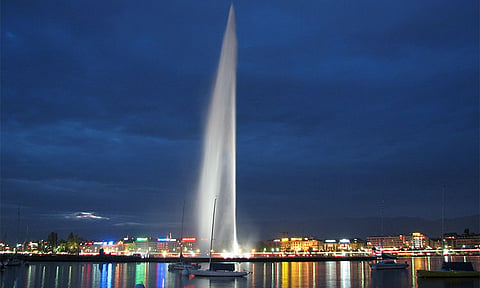Saudi Arabia 'Destination for Muslims' tourism drive: a guide
New initiative forms part of Vision 2030, to make Kingdom the preferred destination for Muslim tourists from all around the world

The “Destination for Muslims” initiative — launched as part of the Vision 2030 unveiled last year by Saudi Arabia — targets Umrah visitors, Muslim traders, state guests from other Muslim countries to visit other sites in the country outside the Muslims holy sites of Makkah and Madinah.
At the same time, the initiative seeks to boost tourism infrastructure investments, mainly through private-public partnerships (PPPs).
What that means is the private sector will be increasingly involved in developing tourist sites to support the influx of visitors to the country's major attractions.
Saudi Arabia, with a land area of 2.15 million square kilometres, is geographically the fifth-largest state in Asia.
In terms of tourist sites, it boasts of unique communities thriving in the magestic mountain ranges in the south-western Asir region, the ancient Nabatean sites of Madain Saleh in the northwest, the historic city of Diriyah (a Unesco world heritage centre) where the first Saudi State was established in 1745 in the central Arabian peninsula, and the imposing tower houses and souqs of the old district of Balad in Jeddah — to name just a few.
Houses built on mountainsides of Asir mountain ranges in south-western Saudi Arabia. - Photo courtesy: Mustafa Sahloli
Initially, the push is to attract tourists from Muslim countries who visit Saudi Arabia for the annual Haj pilgrimage and Umrah.
Every year, millions of Muslims travel from around the world to Saudi Arabia to complete the pilgrimage in the holy city of Makkah.
The Saudi UNESCO site of Diriyah. The historic city is where the first Saudi State was established in 1745. A heritage hotel is being planned near the site.
Last year, 2 million Muslim pilgrims from all over the world gathered in Makkah.
The Jeddah-based Arab News reported that the Saudi Commission for Tourism and National Heritage (SCTH) has launched the initiative to make Saudi Arabia the preferred destination for Muslim tourists from all around the world.
Public-private partnership
Tourism is a key sector identified by Saudi authorities with the most potential to generate jobs and boost the economy.
Saud Al-Mogbil, SCTH spokesman, said all the initiatives of the National Transformation Programme 2020 demand a PPP model.
The King Fahd Fountain in Jeddah, Saudi Arabia, is the world's tallest fountain, reaching a height of about 312 meters (1,024 feet), thus making it taller than the Eiffel Tower (including the antenna). The second-tallest is the Gateway Geyser in East St. Louis, Illinois, USA., which reaches about 192 meters (630 feet).
A public–private partnership (PPP, 3P or P3) is a cooperative arrangement between two or more public and private sectors, typically of a long-term nature.
Ornate wooden lattices used as wind breakers adorn every room in the old houses in Historic Jeddah. - Courtesy: Rima
“SCTH is building a productive PPP initiative that will transform the national tourism sector and contribute significantly to Saudi Vision 2030,” Al-Mogbil told the Jeddah-based paper.
He added that the SCTH is linking up with key partners such as the ministries of interior, foreign affairs, Hajj and Umrah and the Saudi Arabian Airlines.
Vision 2030
“SCTH President Prince Sultan Bin Salman is the mastermind of this initiative," said Al Mogbil.
The Madinah area is rich in precious Islamic inscriptions engraved on rocks.
The programme is an offshoot of Saudi Vision 2030, a "transformation plan" that has identified tourism as one of the main sectors with the potential to deliver lasting economic benefits and positive social changes in a post-oil economy, said Al-Mogbil.
Under the “Destination for Muslims” drive, Umrah travelers are given the option to enrich their visit by enjoying high-quality tourism products following the completion of their religious rituals.
Abha city, in Saudi Arabia, is known for its cooler clime, natural beauty as well as historical, social and cultural heritage. It also has unique agricultural environment and is also known for its unique rosewater. Saudis flock to the mountain city to attend its festivals.
The move is also seen as a major tourism investment booster, the official said.
Under the programme, four important groups are targetted: Umrah visitors, Muslim businesspeople, state guests from other Muslim countries, and Muslim transit passengers.
“Its success, however, is closely related to several other areas of focus by the SCTH — such as exhibitions and conferences, cultural heritage and wellness tourism,” the official said.
“To cater for such a broad range of activities," the official said, "SCTH is engaged in an ambitious development programme of infrastructure (development) and training to create a tourism environment that can deliver these tourism experiences.”
The old houses of historic Jeddah, some rising to a height of more than 30 metres, serve as an authentic and genuine art form. The houses here were built using rocks quarried from the nearby lake. The builders used clay dug out from the bottom of Bahr Al-teen to bind the rocks. Jeddah's old houses are how part of the Unesco world heritage site.
Sign up for the Daily Briefing
Get the latest news and updates straight to your inbox


